Unite 8
VerifiedAdded on 2023/01/10
|14
|4032
|92
AI Summary
Innov and commerce
Contribute Materials
Your contribution can guide someone’s learning journey. Share your
documents today.
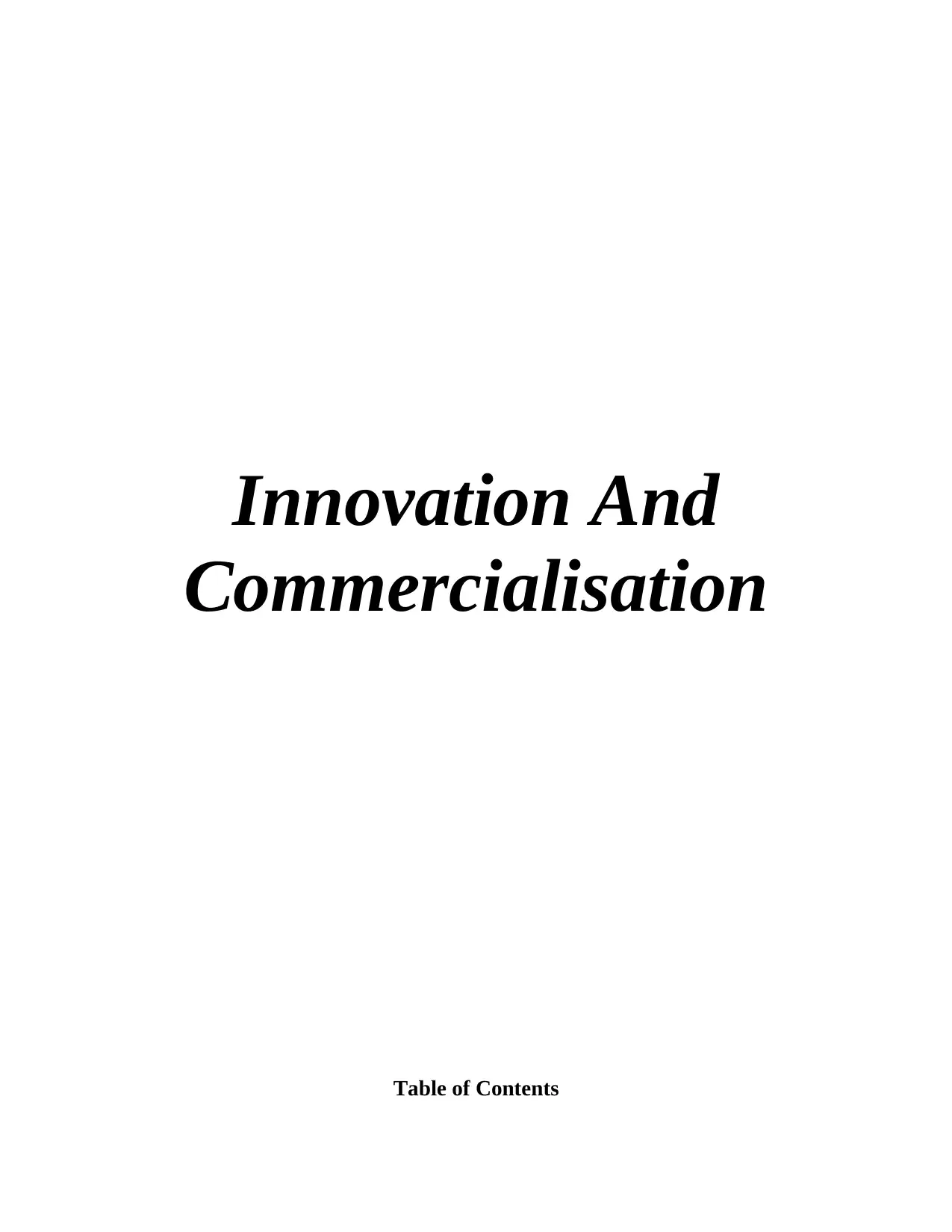
Innovation And
Commercialisation
Table of Contents
Commercialisation
Table of Contents
Secure Best Marks with AI Grader
Need help grading? Try our AI Grader for instant feedback on your assignments.
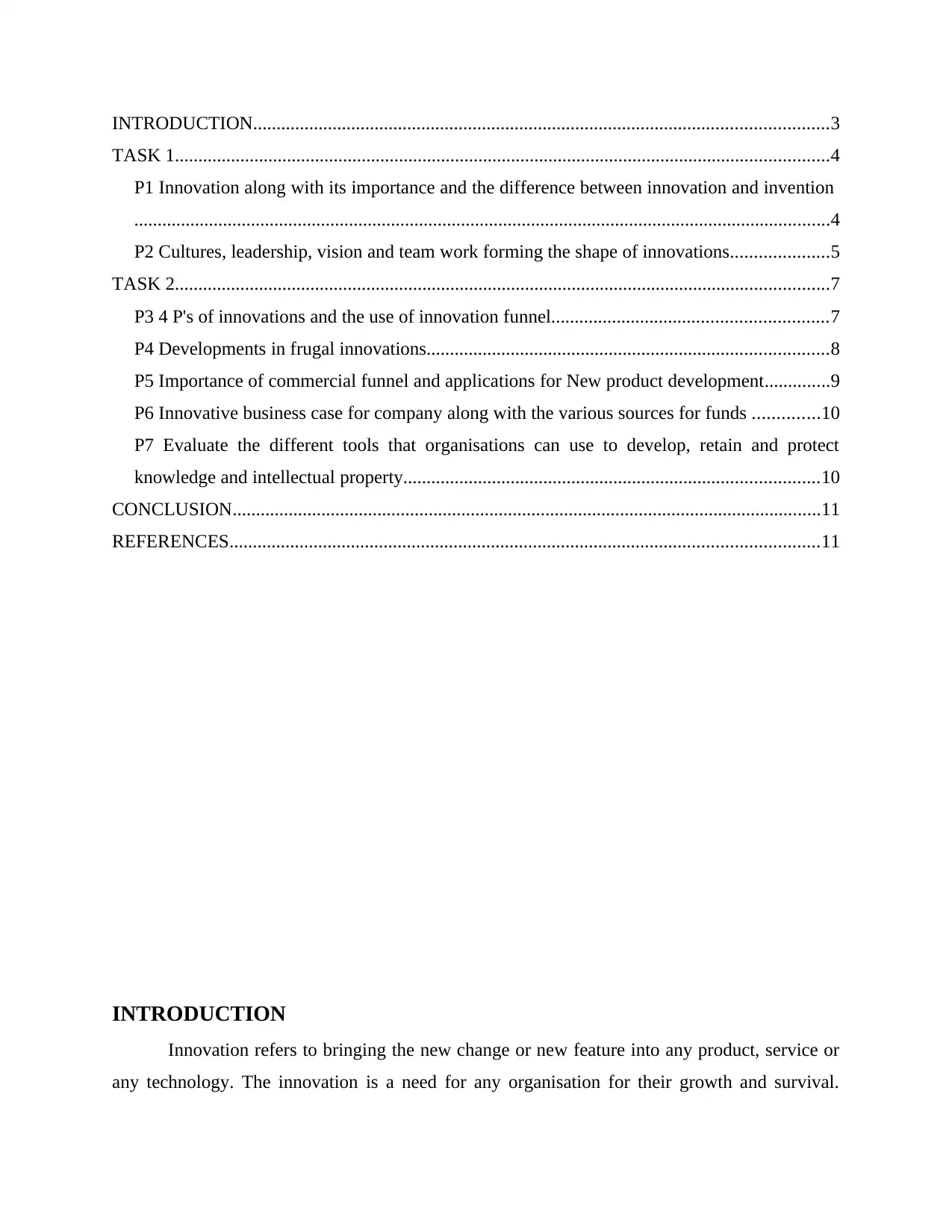
INTRODUCTION...........................................................................................................................3
TASK 1............................................................................................................................................4
P1 Innovation along with its importance and the difference between innovation and invention
.....................................................................................................................................................4
P2 Cultures, leadership, vision and team work forming the shape of innovations.....................5
TASK 2............................................................................................................................................7
P3 4 P's of innovations and the use of innovation funnel...........................................................7
P4 Developments in frugal innovations......................................................................................8
P5 Importance of commercial funnel and applications for New product development..............9
P6 Innovative business case for company along with the various sources for funds ..............10
P7 Evaluate the different tools that organisations can use to develop, retain and protect
knowledge and intellectual property.........................................................................................10
CONCLUSION..............................................................................................................................11
REFERENCES..............................................................................................................................11
INTRODUCTION
Innovation refers to bringing the new change or new feature into any product, service or
any technology. The innovation is a need for any organisation for their growth and survival.
TASK 1............................................................................................................................................4
P1 Innovation along with its importance and the difference between innovation and invention
.....................................................................................................................................................4
P2 Cultures, leadership, vision and team work forming the shape of innovations.....................5
TASK 2............................................................................................................................................7
P3 4 P's of innovations and the use of innovation funnel...........................................................7
P4 Developments in frugal innovations......................................................................................8
P5 Importance of commercial funnel and applications for New product development..............9
P6 Innovative business case for company along with the various sources for funds ..............10
P7 Evaluate the different tools that organisations can use to develop, retain and protect
knowledge and intellectual property.........................................................................................10
CONCLUSION..............................................................................................................................11
REFERENCES..............................................................................................................................11
INTRODUCTION
Innovation refers to bringing the new change or new feature into any product, service or
any technology. The innovation is a need for any organisation for their growth and survival.
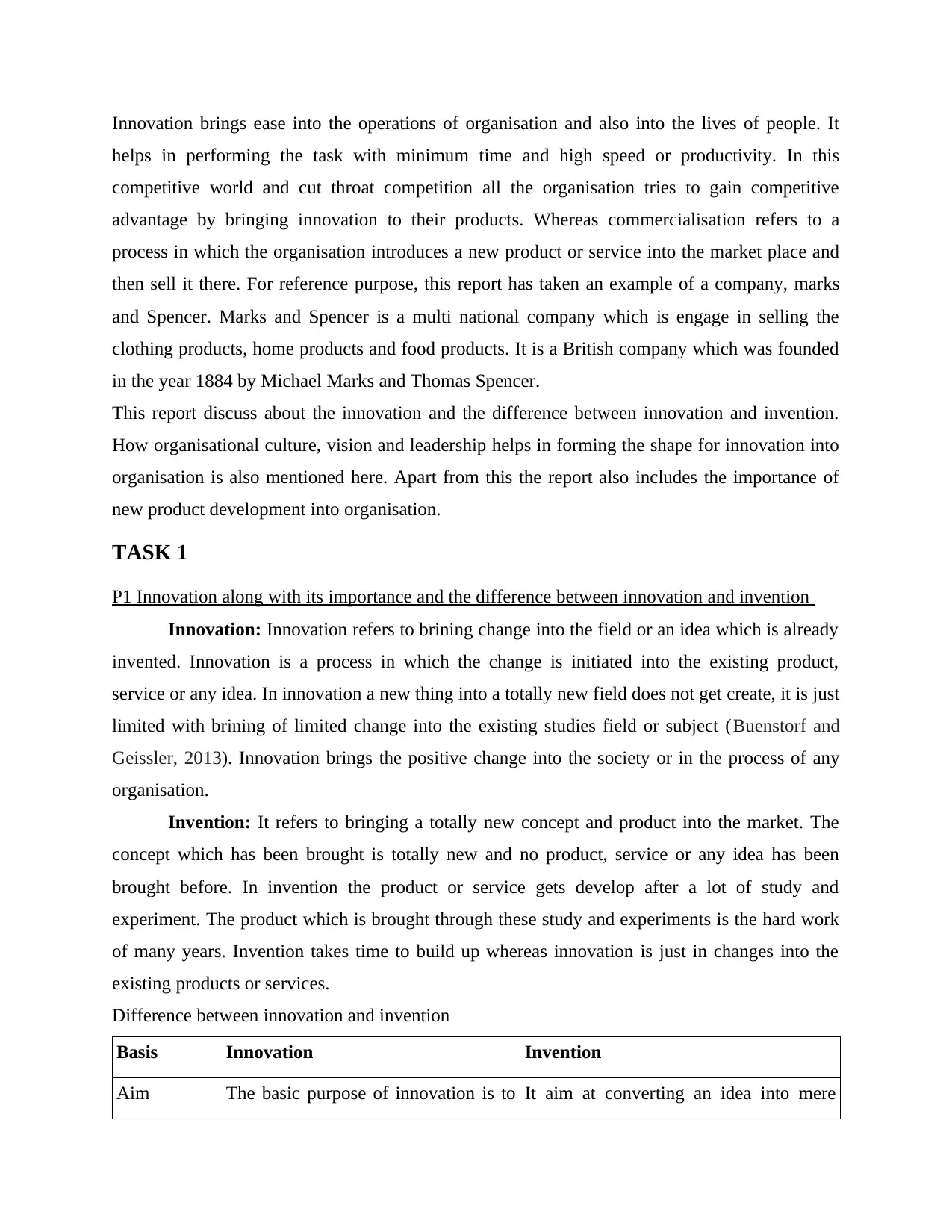
Innovation brings ease into the operations of organisation and also into the lives of people. It
helps in performing the task with minimum time and high speed or productivity. In this
competitive world and cut throat competition all the organisation tries to gain competitive
advantage by bringing innovation to their products. Whereas commercialisation refers to a
process in which the organisation introduces a new product or service into the market place and
then sell it there. For reference purpose, this report has taken an example of a company, marks
and Spencer. Marks and Spencer is a multi national company which is engage in selling the
clothing products, home products and food products. It is a British company which was founded
in the year 1884 by Michael Marks and Thomas Spencer.
This report discuss about the innovation and the difference between innovation and invention.
How organisational culture, vision and leadership helps in forming the shape for innovation into
organisation is also mentioned here. Apart from this the report also includes the importance of
new product development into organisation.
TASK 1
P1 Innovation along with its importance and the difference between innovation and invention
Innovation: Innovation refers to brining change into the field or an idea which is already
invented. Innovation is a process in which the change is initiated into the existing product,
service or any idea. In innovation a new thing into a totally new field does not get create, it is just
limited with brining of limited change into the existing studies field or subject (Buenstorf and
Geissler, 2013). Innovation brings the positive change into the society or in the process of any
organisation.
Invention: It refers to bringing a totally new concept and product into the market. The
concept which has been brought is totally new and no product, service or any idea has been
brought before. In invention the product or service gets develop after a lot of study and
experiment. The product which is brought through these study and experiments is the hard work
of many years. Invention takes time to build up whereas innovation is just in changes into the
existing products or services.
Difference between innovation and invention
Basis Innovation Invention
Aim The basic purpose of innovation is to It aim at converting an idea into mere
helps in performing the task with minimum time and high speed or productivity. In this
competitive world and cut throat competition all the organisation tries to gain competitive
advantage by bringing innovation to their products. Whereas commercialisation refers to a
process in which the organisation introduces a new product or service into the market place and
then sell it there. For reference purpose, this report has taken an example of a company, marks
and Spencer. Marks and Spencer is a multi national company which is engage in selling the
clothing products, home products and food products. It is a British company which was founded
in the year 1884 by Michael Marks and Thomas Spencer.
This report discuss about the innovation and the difference between innovation and invention.
How organisational culture, vision and leadership helps in forming the shape for innovation into
organisation is also mentioned here. Apart from this the report also includes the importance of
new product development into organisation.
TASK 1
P1 Innovation along with its importance and the difference between innovation and invention
Innovation: Innovation refers to brining change into the field or an idea which is already
invented. Innovation is a process in which the change is initiated into the existing product,
service or any idea. In innovation a new thing into a totally new field does not get create, it is just
limited with brining of limited change into the existing studies field or subject (Buenstorf and
Geissler, 2013). Innovation brings the positive change into the society or in the process of any
organisation.
Invention: It refers to bringing a totally new concept and product into the market. The
concept which has been brought is totally new and no product, service or any idea has been
brought before. In invention the product or service gets develop after a lot of study and
experiment. The product which is brought through these study and experiments is the hard work
of many years. Invention takes time to build up whereas innovation is just in changes into the
existing products or services.
Difference between innovation and invention
Basis Innovation Invention
Aim The basic purpose of innovation is to It aim at converting an idea into mere
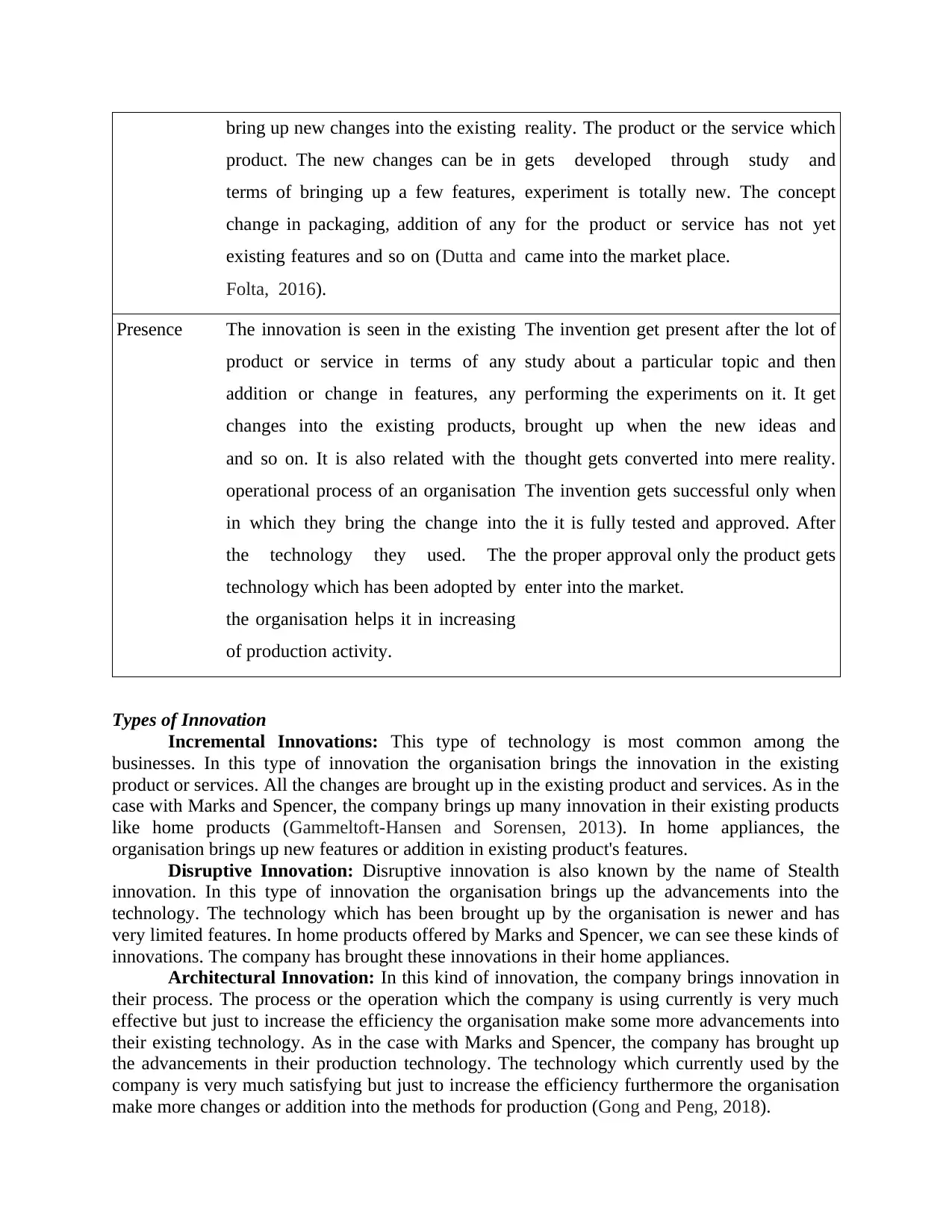
bring up new changes into the existing
product. The new changes can be in
terms of bringing up a few features,
change in packaging, addition of any
existing features and so on (Dutta and
Folta, 2016).
reality. The product or the service which
gets developed through study and
experiment is totally new. The concept
for the product or service has not yet
came into the market place.
Presence The innovation is seen in the existing
product or service in terms of any
addition or change in features, any
changes into the existing products,
and so on. It is also related with the
operational process of an organisation
in which they bring the change into
the technology they used. The
technology which has been adopted by
the organisation helps it in increasing
of production activity.
The invention get present after the lot of
study about a particular topic and then
performing the experiments on it. It get
brought up when the new ideas and
thought gets converted into mere reality.
The invention gets successful only when
the it is fully tested and approved. After
the proper approval only the product gets
enter into the market.
Types of Innovation
Incremental Innovations: This type of technology is most common among the
businesses. In this type of innovation the organisation brings the innovation in the existing
product or services. All the changes are brought up in the existing product and services. As in the
case with Marks and Spencer, the company brings up many innovation in their existing products
like home products (Gammeltoft-Hansen and Sorensen, 2013). In home appliances, the
organisation brings up new features or addition in existing product's features.
Disruptive Innovation: Disruptive innovation is also known by the name of Stealth
innovation. In this type of innovation the organisation brings up the advancements into the
technology. The technology which has been brought up by the organisation is newer and has
very limited features. In home products offered by Marks and Spencer, we can see these kinds of
innovations. The company has brought these innovations in their home appliances.
Architectural Innovation: In this kind of innovation, the company brings innovation in
their process. The process or the operation which the company is using currently is very much
effective but just to increase the efficiency the organisation make some more advancements into
their existing technology. As in the case with Marks and Spencer, the company has brought up
the advancements in their production technology. The technology which currently used by the
company is very much satisfying but just to increase the efficiency furthermore the organisation
make more changes or addition into the methods for production (Gong and Peng, 2018).
product. The new changes can be in
terms of bringing up a few features,
change in packaging, addition of any
existing features and so on (Dutta and
Folta, 2016).
reality. The product or the service which
gets developed through study and
experiment is totally new. The concept
for the product or service has not yet
came into the market place.
Presence The innovation is seen in the existing
product or service in terms of any
addition or change in features, any
changes into the existing products,
and so on. It is also related with the
operational process of an organisation
in which they bring the change into
the technology they used. The
technology which has been adopted by
the organisation helps it in increasing
of production activity.
The invention get present after the lot of
study about a particular topic and then
performing the experiments on it. It get
brought up when the new ideas and
thought gets converted into mere reality.
The invention gets successful only when
the it is fully tested and approved. After
the proper approval only the product gets
enter into the market.
Types of Innovation
Incremental Innovations: This type of technology is most common among the
businesses. In this type of innovation the organisation brings the innovation in the existing
product or services. All the changes are brought up in the existing product and services. As in the
case with Marks and Spencer, the company brings up many innovation in their existing products
like home products (Gammeltoft-Hansen and Sorensen, 2013). In home appliances, the
organisation brings up new features or addition in existing product's features.
Disruptive Innovation: Disruptive innovation is also known by the name of Stealth
innovation. In this type of innovation the organisation brings up the advancements into the
technology. The technology which has been brought up by the organisation is newer and has
very limited features. In home products offered by Marks and Spencer, we can see these kinds of
innovations. The company has brought these innovations in their home appliances.
Architectural Innovation: In this kind of innovation, the company brings innovation in
their process. The process or the operation which the company is using currently is very much
effective but just to increase the efficiency the organisation make some more advancements into
their existing technology. As in the case with Marks and Spencer, the company has brought up
the advancements in their production technology. The technology which currently used by the
company is very much satisfying but just to increase the efficiency furthermore the organisation
make more changes or addition into the methods for production (Gong and Peng, 2018).
Secure Best Marks with AI Grader
Need help grading? Try our AI Grader for instant feedback on your assignments.
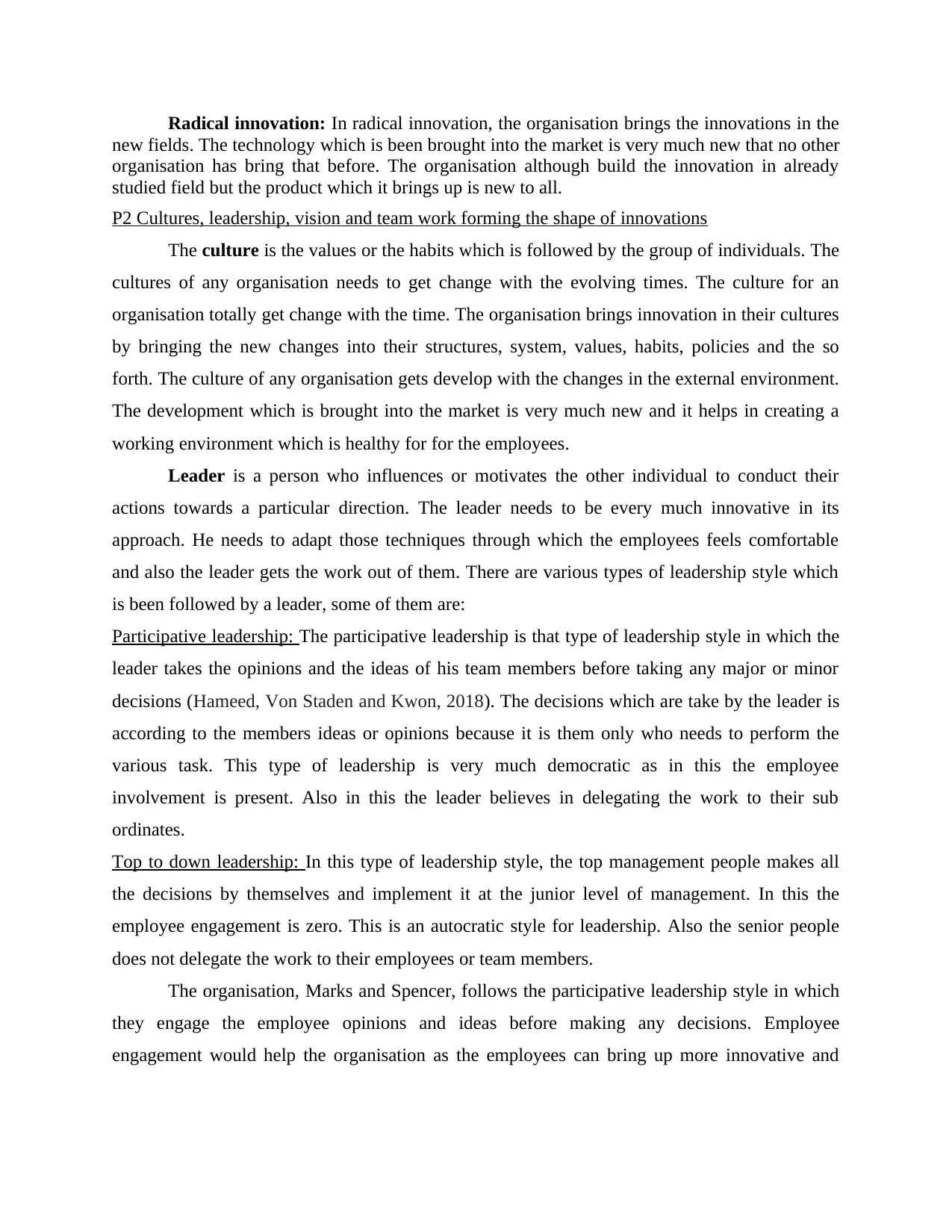
Radical innovation: In radical innovation, the organisation brings the innovations in the
new fields. The technology which is been brought into the market is very much new that no other
organisation has bring that before. The organisation although build the innovation in already
studied field but the product which it brings up is new to all.
P2 Cultures, leadership, vision and team work forming the shape of innovations
The culture is the values or the habits which is followed by the group of individuals. The
cultures of any organisation needs to get change with the evolving times. The culture for an
organisation totally get change with the time. The organisation brings innovation in their cultures
by bringing the new changes into their structures, system, values, habits, policies and the so
forth. The culture of any organisation gets develop with the changes in the external environment.
The development which is brought into the market is very much new and it helps in creating a
working environment which is healthy for for the employees.
Leader is a person who influences or motivates the other individual to conduct their
actions towards a particular direction. The leader needs to be every much innovative in its
approach. He needs to adapt those techniques through which the employees feels comfortable
and also the leader gets the work out of them. There are various types of leadership style which
is been followed by a leader, some of them are:
Participative leadership: The participative leadership is that type of leadership style in which the
leader takes the opinions and the ideas of his team members before taking any major or minor
decisions (Hameed, Von Staden and Kwon, 2018). The decisions which are take by the leader is
according to the members ideas or opinions because it is them only who needs to perform the
various task. This type of leadership is very much democratic as in this the employee
involvement is present. Also in this the leader believes in delegating the work to their sub
ordinates.
Top to down leadership: In this type of leadership style, the top management people makes all
the decisions by themselves and implement it at the junior level of management. In this the
employee engagement is zero. This is an autocratic style for leadership. Also the senior people
does not delegate the work to their employees or team members.
The organisation, Marks and Spencer, follows the participative leadership style in which
they engage the employee opinions and ideas before making any decisions. Employee
engagement would help the organisation as the employees can bring up more innovative and
new fields. The technology which is been brought into the market is very much new that no other
organisation has bring that before. The organisation although build the innovation in already
studied field but the product which it brings up is new to all.
P2 Cultures, leadership, vision and team work forming the shape of innovations
The culture is the values or the habits which is followed by the group of individuals. The
cultures of any organisation needs to get change with the evolving times. The culture for an
organisation totally get change with the time. The organisation brings innovation in their cultures
by bringing the new changes into their structures, system, values, habits, policies and the so
forth. The culture of any organisation gets develop with the changes in the external environment.
The development which is brought into the market is very much new and it helps in creating a
working environment which is healthy for for the employees.
Leader is a person who influences or motivates the other individual to conduct their
actions towards a particular direction. The leader needs to be every much innovative in its
approach. He needs to adapt those techniques through which the employees feels comfortable
and also the leader gets the work out of them. There are various types of leadership style which
is been followed by a leader, some of them are:
Participative leadership: The participative leadership is that type of leadership style in which the
leader takes the opinions and the ideas of his team members before taking any major or minor
decisions (Hameed, Von Staden and Kwon, 2018). The decisions which are take by the leader is
according to the members ideas or opinions because it is them only who needs to perform the
various task. This type of leadership is very much democratic as in this the employee
involvement is present. Also in this the leader believes in delegating the work to their sub
ordinates.
Top to down leadership: In this type of leadership style, the top management people makes all
the decisions by themselves and implement it at the junior level of management. In this the
employee engagement is zero. This is an autocratic style for leadership. Also the senior people
does not delegate the work to their employees or team members.
The organisation, Marks and Spencer, follows the participative leadership style in which
they engage the employee opinions and ideas before making any decisions. Employee
engagement would help the organisation as the employees can bring up more innovative and
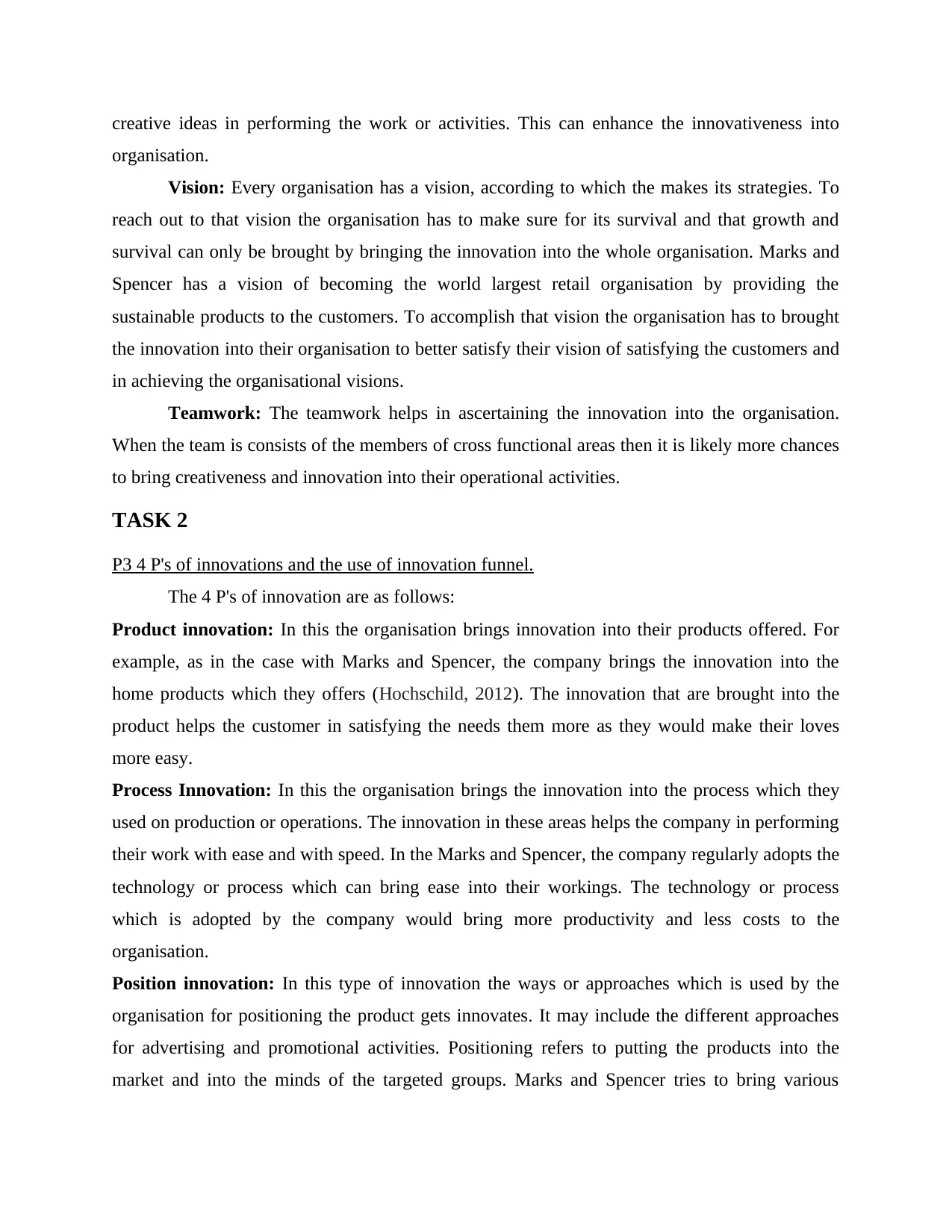
creative ideas in performing the work or activities. This can enhance the innovativeness into
organisation.
Vision: Every organisation has a vision, according to which the makes its strategies. To
reach out to that vision the organisation has to make sure for its survival and that growth and
survival can only be brought by bringing the innovation into the whole organisation. Marks and
Spencer has a vision of becoming the world largest retail organisation by providing the
sustainable products to the customers. To accomplish that vision the organisation has to brought
the innovation into their organisation to better satisfy their vision of satisfying the customers and
in achieving the organisational visions.
Teamwork: The teamwork helps in ascertaining the innovation into the organisation.
When the team is consists of the members of cross functional areas then it is likely more chances
to bring creativeness and innovation into their operational activities.
TASK 2
P3 4 P's of innovations and the use of innovation funnel.
The 4 P's of innovation are as follows:
Product innovation: In this the organisation brings innovation into their products offered. For
example, as in the case with Marks and Spencer, the company brings the innovation into the
home products which they offers (Hochschild, 2012). The innovation that are brought into the
product helps the customer in satisfying the needs them more as they would make their loves
more easy.
Process Innovation: In this the organisation brings the innovation into the process which they
used on production or operations. The innovation in these areas helps the company in performing
their work with ease and with speed. In the Marks and Spencer, the company regularly adopts the
technology or process which can bring ease into their workings. The technology or process
which is adopted by the company would bring more productivity and less costs to the
organisation.
Position innovation: In this type of innovation the ways or approaches which is used by the
organisation for positioning the product gets innovates. It may include the different approaches
for advertising and promotional activities. Positioning refers to putting the products into the
market and into the minds of the targeted groups. Marks and Spencer tries to bring various
organisation.
Vision: Every organisation has a vision, according to which the makes its strategies. To
reach out to that vision the organisation has to make sure for its survival and that growth and
survival can only be brought by bringing the innovation into the whole organisation. Marks and
Spencer has a vision of becoming the world largest retail organisation by providing the
sustainable products to the customers. To accomplish that vision the organisation has to brought
the innovation into their organisation to better satisfy their vision of satisfying the customers and
in achieving the organisational visions.
Teamwork: The teamwork helps in ascertaining the innovation into the organisation.
When the team is consists of the members of cross functional areas then it is likely more chances
to bring creativeness and innovation into their operational activities.
TASK 2
P3 4 P's of innovations and the use of innovation funnel.
The 4 P's of innovation are as follows:
Product innovation: In this the organisation brings innovation into their products offered. For
example, as in the case with Marks and Spencer, the company brings the innovation into the
home products which they offers (Hochschild, 2012). The innovation that are brought into the
product helps the customer in satisfying the needs them more as they would make their loves
more easy.
Process Innovation: In this the organisation brings the innovation into the process which they
used on production or operations. The innovation in these areas helps the company in performing
their work with ease and with speed. In the Marks and Spencer, the company regularly adopts the
technology or process which can bring ease into their workings. The technology or process
which is adopted by the company would bring more productivity and less costs to the
organisation.
Position innovation: In this type of innovation the ways or approaches which is used by the
organisation for positioning the product gets innovates. It may include the different approaches
for advertising and promotional activities. Positioning refers to putting the products into the
market and into the minds of the targeted groups. Marks and Spencer tries to bring various
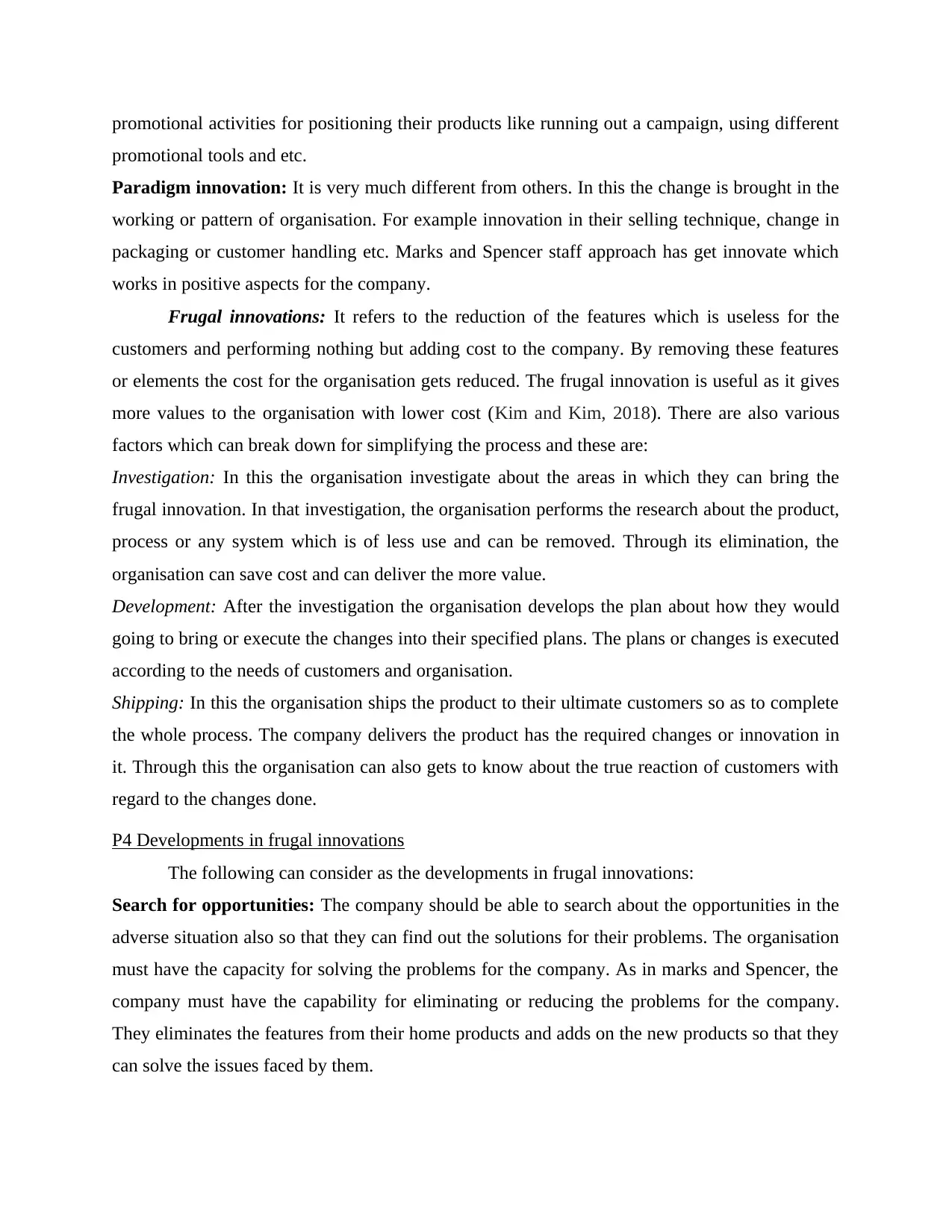
promotional activities for positioning their products like running out a campaign, using different
promotional tools and etc.
Paradigm innovation: It is very much different from others. In this the change is brought in the
working or pattern of organisation. For example innovation in their selling technique, change in
packaging or customer handling etc. Marks and Spencer staff approach has get innovate which
works in positive aspects for the company.
Frugal innovations: It refers to the reduction of the features which is useless for the
customers and performing nothing but adding cost to the company. By removing these features
or elements the cost for the organisation gets reduced. The frugal innovation is useful as it gives
more values to the organisation with lower cost (Kim and Kim, 2018). There are also various
factors which can break down for simplifying the process and these are:
Investigation: In this the organisation investigate about the areas in which they can bring the
frugal innovation. In that investigation, the organisation performs the research about the product,
process or any system which is of less use and can be removed. Through its elimination, the
organisation can save cost and can deliver the more value.
Development: After the investigation the organisation develops the plan about how they would
going to bring or execute the changes into their specified plans. The plans or changes is executed
according to the needs of customers and organisation.
Shipping: In this the organisation ships the product to their ultimate customers so as to complete
the whole process. The company delivers the product has the required changes or innovation in
it. Through this the organisation can also gets to know about the true reaction of customers with
regard to the changes done.
P4 Developments in frugal innovations
The following can consider as the developments in frugal innovations:
Search for opportunities: The company should be able to search about the opportunities in the
adverse situation also so that they can find out the solutions for their problems. The organisation
must have the capacity for solving the problems for the company. As in marks and Spencer, the
company must have the capability for eliminating or reducing the problems for the company.
They eliminates the features from their home products and adds on the new products so that they
can solve the issues faced by them.
promotional tools and etc.
Paradigm innovation: It is very much different from others. In this the change is brought in the
working or pattern of organisation. For example innovation in their selling technique, change in
packaging or customer handling etc. Marks and Spencer staff approach has get innovate which
works in positive aspects for the company.
Frugal innovations: It refers to the reduction of the features which is useless for the
customers and performing nothing but adding cost to the company. By removing these features
or elements the cost for the organisation gets reduced. The frugal innovation is useful as it gives
more values to the organisation with lower cost (Kim and Kim, 2018). There are also various
factors which can break down for simplifying the process and these are:
Investigation: In this the organisation investigate about the areas in which they can bring the
frugal innovation. In that investigation, the organisation performs the research about the product,
process or any system which is of less use and can be removed. Through its elimination, the
organisation can save cost and can deliver the more value.
Development: After the investigation the organisation develops the plan about how they would
going to bring or execute the changes into their specified plans. The plans or changes is executed
according to the needs of customers and organisation.
Shipping: In this the organisation ships the product to their ultimate customers so as to complete
the whole process. The company delivers the product has the required changes or innovation in
it. Through this the organisation can also gets to know about the true reaction of customers with
regard to the changes done.
P4 Developments in frugal innovations
The following can consider as the developments in frugal innovations:
Search for opportunities: The company should be able to search about the opportunities in the
adverse situation also so that they can find out the solutions for their problems. The organisation
must have the capacity for solving the problems for the company. As in marks and Spencer, the
company must have the capability for eliminating or reducing the problems for the company.
They eliminates the features from their home products and adds on the new products so that they
can solve the issues faced by them.
Paraphrase This Document
Need a fresh take? Get an instant paraphrase of this document with our AI Paraphraser
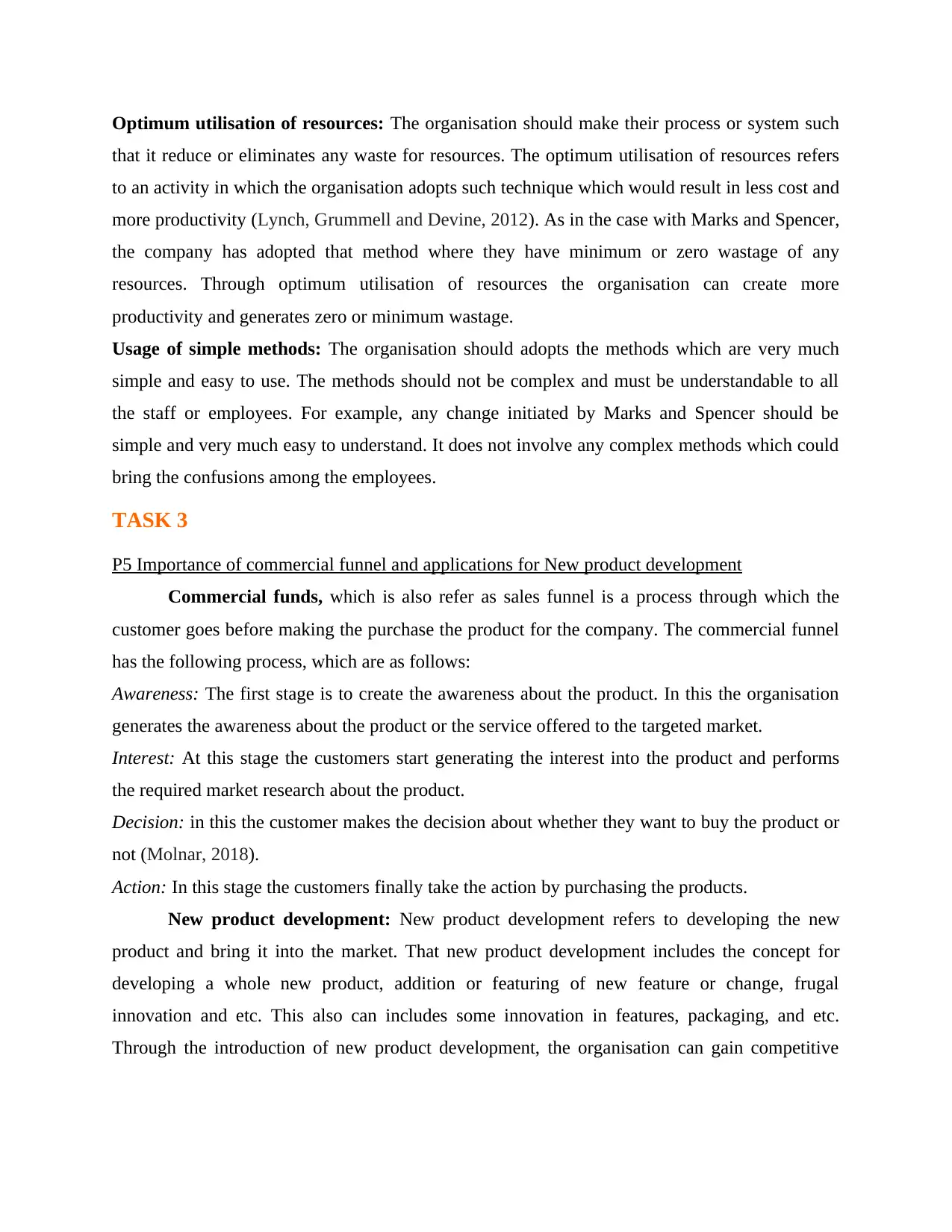
Optimum utilisation of resources: The organisation should make their process or system such
that it reduce or eliminates any waste for resources. The optimum utilisation of resources refers
to an activity in which the organisation adopts such technique which would result in less cost and
more productivity (Lynch, Grummell and Devine, 2012). As in the case with Marks and Spencer,
the company has adopted that method where they have minimum or zero wastage of any
resources. Through optimum utilisation of resources the organisation can create more
productivity and generates zero or minimum wastage.
Usage of simple methods: The organisation should adopts the methods which are very much
simple and easy to use. The methods should not be complex and must be understandable to all
the staff or employees. For example, any change initiated by Marks and Spencer should be
simple and very much easy to understand. It does not involve any complex methods which could
bring the confusions among the employees.
TASK 3
P5 Importance of commercial funnel and applications for New product development
Commercial funds, which is also refer as sales funnel is a process through which the
customer goes before making the purchase the product for the company. The commercial funnel
has the following process, which are as follows:
Awareness: The first stage is to create the awareness about the product. In this the organisation
generates the awareness about the product or the service offered to the targeted market.
Interest: At this stage the customers start generating the interest into the product and performs
the required market research about the product.
Decision: in this the customer makes the decision about whether they want to buy the product or
not (Molnar, 2018).
Action: In this stage the customers finally take the action by purchasing the products.
New product development: New product development refers to developing the new
product and bring it into the market. That new product development includes the concept for
developing a whole new product, addition or featuring of new feature or change, frugal
innovation and etc. This also can includes some innovation in features, packaging, and etc.
Through the introduction of new product development, the organisation can gain competitive
that it reduce or eliminates any waste for resources. The optimum utilisation of resources refers
to an activity in which the organisation adopts such technique which would result in less cost and
more productivity (Lynch, Grummell and Devine, 2012). As in the case with Marks and Spencer,
the company has adopted that method where they have minimum or zero wastage of any
resources. Through optimum utilisation of resources the organisation can create more
productivity and generates zero or minimum wastage.
Usage of simple methods: The organisation should adopts the methods which are very much
simple and easy to use. The methods should not be complex and must be understandable to all
the staff or employees. For example, any change initiated by Marks and Spencer should be
simple and very much easy to understand. It does not involve any complex methods which could
bring the confusions among the employees.
TASK 3
P5 Importance of commercial funnel and applications for New product development
Commercial funds, which is also refer as sales funnel is a process through which the
customer goes before making the purchase the product for the company. The commercial funnel
has the following process, which are as follows:
Awareness: The first stage is to create the awareness about the product. In this the organisation
generates the awareness about the product or the service offered to the targeted market.
Interest: At this stage the customers start generating the interest into the product and performs
the required market research about the product.
Decision: in this the customer makes the decision about whether they want to buy the product or
not (Molnar, 2018).
Action: In this stage the customers finally take the action by purchasing the products.
New product development: New product development refers to developing the new
product and bring it into the market. That new product development includes the concept for
developing a whole new product, addition or featuring of new feature or change, frugal
innovation and etc. This also can includes some innovation in features, packaging, and etc.
Through the introduction of new product development, the organisation can gain competitive

advantage into the market. This also helps the organisation in attracting the new customers along
with the existing customer base.
The following are the process of new product development:
Idea generation: In this step the idea gets build up into a person's mind.
Development concept: In this stage, the person or the organisation tries to develops that idea
into mere reality (Sanberg and et. al., 2016). In this step the required studies are conducted and
outlines for the product development gets plan.
Market strategic analysis: In this stage, the organisation makes the strategies analysis of market
by conducting the proper market researches.
Product development: At this stage the organisation tries to develop the product according to
the idea which is generated.
Test marketing: The organisation sells the product into a small segment of market and observe
the reaction of people.
Commercialisation: At this stage the organisation sells its new product which it has developed
into the whole market.
P6 Innovative business case for company along with the various sources for funds
Business case: In this case, the organisation Marks and Spencer is has a project to launch
the new product into the market place. Here the various methods which the company can use for
introducing the product into market place has been given.
Executive summary: Every organisation for its growth and survival has to bring innovation into
their products or systems. Marks and Spencer is a company which has introduced a new product
which is very much innovative and new for the market (Shahid and et. al., 2012). The company
has make plan about how they would going to launch it into the market place.
Competitive edge: The organisation marks and Spencer can bring competitive edge through
bringing innovation in their products which the company has been build up by the company.
Possibilities for size and growth: As marks and Spencer operates around the world, the scope
for the size and growth of the organisation is very large which can bring more profits and growth
for the company.
Funding: The company can use various sources for funds, some of them are follows as:
Personal funding: The company can take out the funds from their company' s account for
launching the product which they have innovate.
with the existing customer base.
The following are the process of new product development:
Idea generation: In this step the idea gets build up into a person's mind.
Development concept: In this stage, the person or the organisation tries to develops that idea
into mere reality (Sanberg and et. al., 2016). In this step the required studies are conducted and
outlines for the product development gets plan.
Market strategic analysis: In this stage, the organisation makes the strategies analysis of market
by conducting the proper market researches.
Product development: At this stage the organisation tries to develop the product according to
the idea which is generated.
Test marketing: The organisation sells the product into a small segment of market and observe
the reaction of people.
Commercialisation: At this stage the organisation sells its new product which it has developed
into the whole market.
P6 Innovative business case for company along with the various sources for funds
Business case: In this case, the organisation Marks and Spencer is has a project to launch
the new product into the market place. Here the various methods which the company can use for
introducing the product into market place has been given.
Executive summary: Every organisation for its growth and survival has to bring innovation into
their products or systems. Marks and Spencer is a company which has introduced a new product
which is very much innovative and new for the market (Shahid and et. al., 2012). The company
has make plan about how they would going to launch it into the market place.
Competitive edge: The organisation marks and Spencer can bring competitive edge through
bringing innovation in their products which the company has been build up by the company.
Possibilities for size and growth: As marks and Spencer operates around the world, the scope
for the size and growth of the organisation is very large which can bring more profits and growth
for the company.
Funding: The company can use various sources for funds, some of them are follows as:
Personal funding: The company can take out the funds from their company' s account for
launching the product which they have innovate.
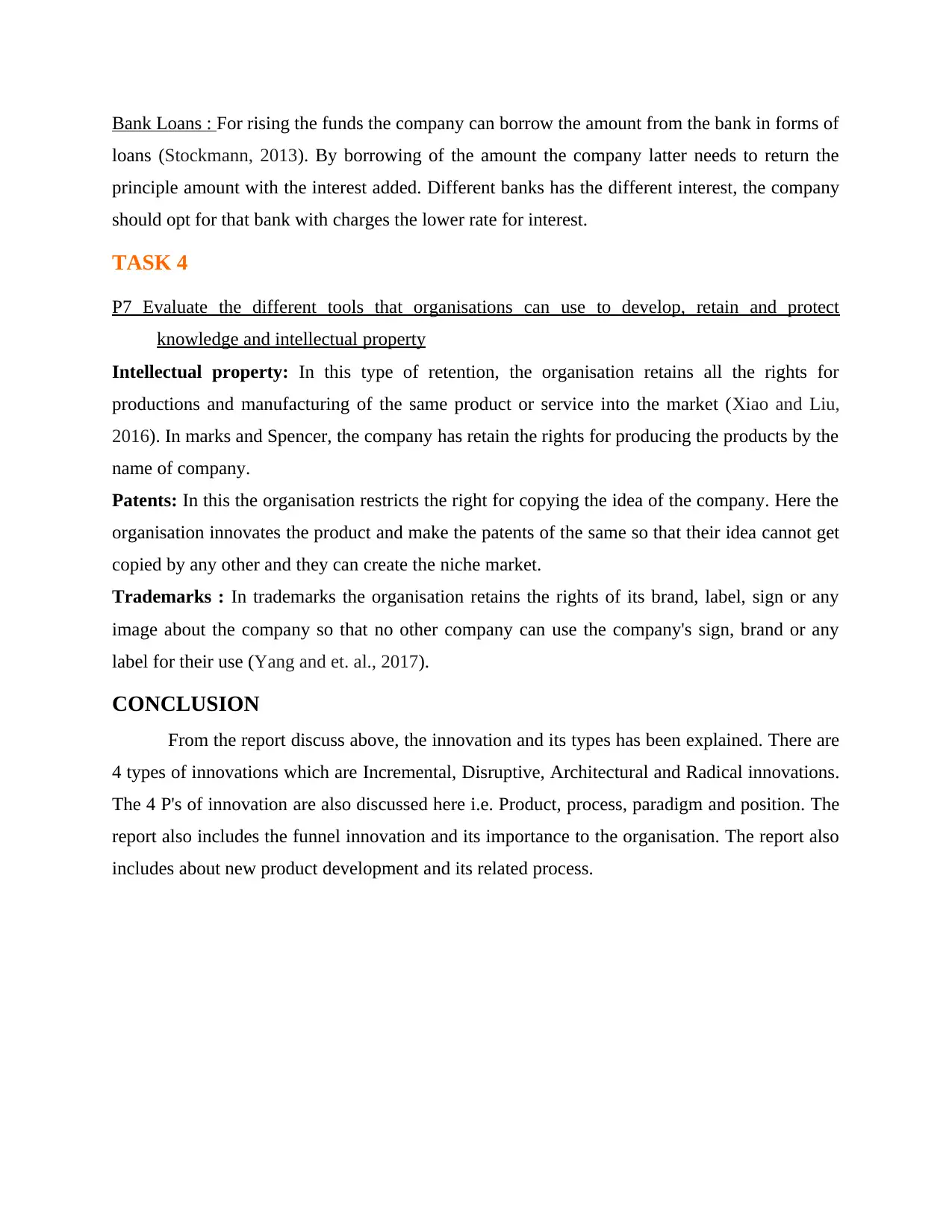
Bank Loans : For rising the funds the company can borrow the amount from the bank in forms of
loans (Stockmann, 2013). By borrowing of the amount the company latter needs to return the
principle amount with the interest added. Different banks has the different interest, the company
should opt for that bank with charges the lower rate for interest.
TASK 4
P7 Evaluate the different tools that organisations can use to develop, retain and protect
knowledge and intellectual property
Intellectual property: In this type of retention, the organisation retains all the rights for
productions and manufacturing of the same product or service into the market (Xiao and Liu,
2016). In marks and Spencer, the company has retain the rights for producing the products by the
name of company.
Patents: In this the organisation restricts the right for copying the idea of the company. Here the
organisation innovates the product and make the patents of the same so that their idea cannot get
copied by any other and they can create the niche market.
Trademarks : In trademarks the organisation retains the rights of its brand, label, sign or any
image about the company so that no other company can use the company's sign, brand or any
label for their use (Yang and et. al., 2017).
CONCLUSION
From the report discuss above, the innovation and its types has been explained. There are
4 types of innovations which are Incremental, Disruptive, Architectural and Radical innovations.
The 4 P's of innovation are also discussed here i.e. Product, process, paradigm and position. The
report also includes the funnel innovation and its importance to the organisation. The report also
includes about new product development and its related process.
loans (Stockmann, 2013). By borrowing of the amount the company latter needs to return the
principle amount with the interest added. Different banks has the different interest, the company
should opt for that bank with charges the lower rate for interest.
TASK 4
P7 Evaluate the different tools that organisations can use to develop, retain and protect
knowledge and intellectual property
Intellectual property: In this type of retention, the organisation retains all the rights for
productions and manufacturing of the same product or service into the market (Xiao and Liu,
2016). In marks and Spencer, the company has retain the rights for producing the products by the
name of company.
Patents: In this the organisation restricts the right for copying the idea of the company. Here the
organisation innovates the product and make the patents of the same so that their idea cannot get
copied by any other and they can create the niche market.
Trademarks : In trademarks the organisation retains the rights of its brand, label, sign or any
image about the company so that no other company can use the company's sign, brand or any
label for their use (Yang and et. al., 2017).
CONCLUSION
From the report discuss above, the innovation and its types has been explained. There are
4 types of innovations which are Incremental, Disruptive, Architectural and Radical innovations.
The 4 P's of innovation are also discussed here i.e. Product, process, paradigm and position. The
report also includes the funnel innovation and its importance to the organisation. The report also
includes about new product development and its related process.
Secure Best Marks with AI Grader
Need help grading? Try our AI Grader for instant feedback on your assignments.
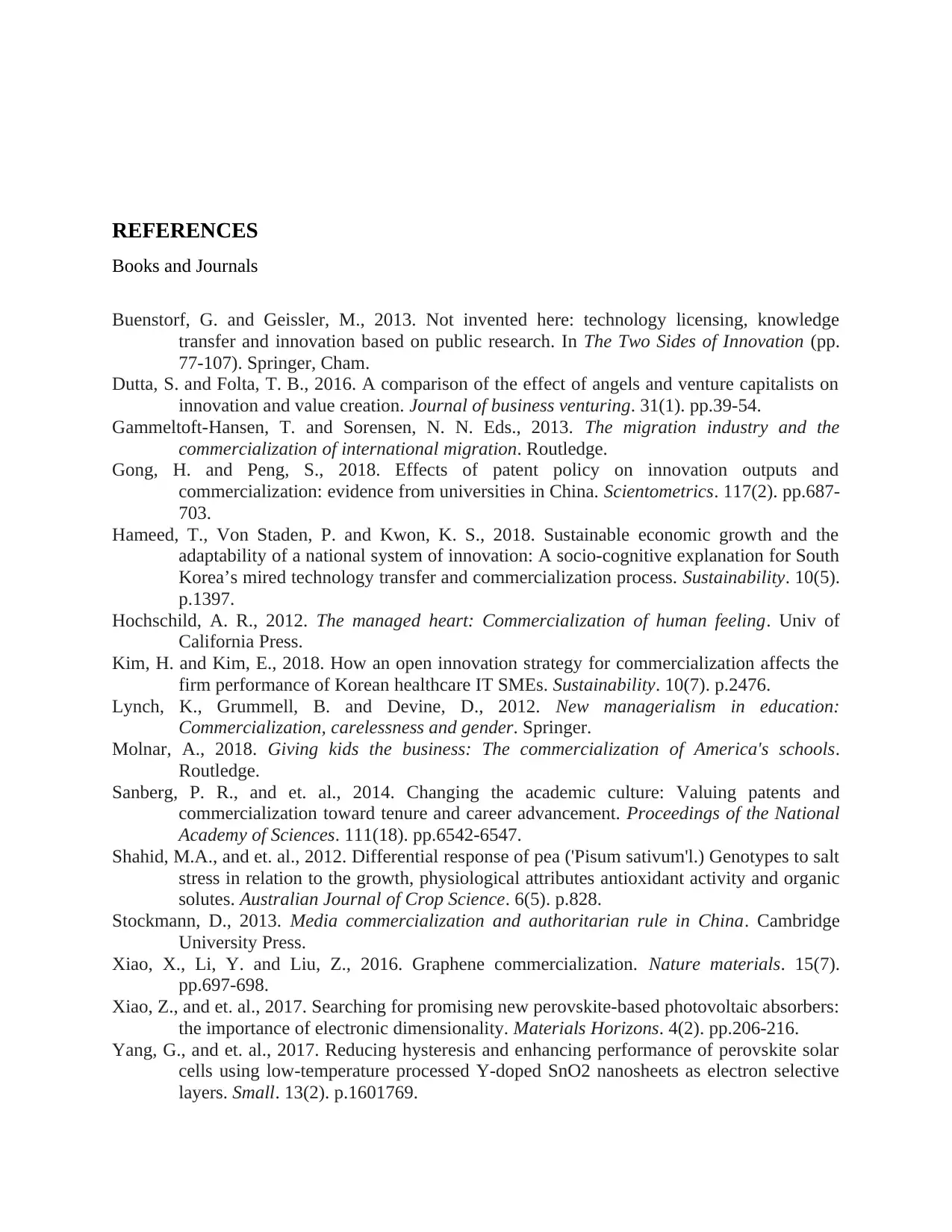
REFERENCES
Books and Journals
Buenstorf, G. and Geissler, M., 2013. Not invented here: technology licensing, knowledge
transfer and innovation based on public research. In The Two Sides of Innovation (pp.
77-107). Springer, Cham.
Dutta, S. and Folta, T. B., 2016. A comparison of the effect of angels and venture capitalists on
innovation and value creation. Journal of business venturing. 31(1). pp.39-54.
Gammeltoft-Hansen, T. and Sorensen, N. N. Eds., 2013. The migration industry and the
commercialization of international migration. Routledge.
Gong, H. and Peng, S., 2018. Effects of patent policy on innovation outputs and
commercialization: evidence from universities in China. Scientometrics. 117(2). pp.687-
703.
Hameed, T., Von Staden, P. and Kwon, K. S., 2018. Sustainable economic growth and the
adaptability of a national system of innovation: A socio-cognitive explanation for South
Korea’s mired technology transfer and commercialization process. Sustainability. 10(5).
p.1397.
Hochschild, A. R., 2012. The managed heart: Commercialization of human feeling. Univ of
California Press.
Kim, H. and Kim, E., 2018. How an open innovation strategy for commercialization affects the
firm performance of Korean healthcare IT SMEs. Sustainability. 10(7). p.2476.
Lynch, K., Grummell, B. and Devine, D., 2012. New managerialism in education:
Commercialization, carelessness and gender. Springer.
Molnar, A., 2018. Giving kids the business: The commercialization of America's schools.
Routledge.
Sanberg, P. R., and et. al., 2014. Changing the academic culture: Valuing patents and
commercialization toward tenure and career advancement. Proceedings of the National
Academy of Sciences. 111(18). pp.6542-6547.
Shahid, M.A., and et. al., 2012. Differential response of pea ('Pisum sativum'l.) Genotypes to salt
stress in relation to the growth, physiological attributes antioxidant activity and organic
solutes. Australian Journal of Crop Science. 6(5). p.828.
Stockmann, D., 2013. Media commercialization and authoritarian rule in China. Cambridge
University Press.
Xiao, X., Li, Y. and Liu, Z., 2016. Graphene commercialization. Nature materials. 15(7).
pp.697-698.
Xiao, Z., and et. al., 2017. Searching for promising new perovskite-based photovoltaic absorbers:
the importance of electronic dimensionality. Materials Horizons. 4(2). pp.206-216.
Yang, G., and et. al., 2017. Reducing hysteresis and enhancing performance of perovskite solar
cells using low‐temperature processed Y‐doped SnO2 nanosheets as electron selective
layers. Small. 13(2). p.1601769.
Books and Journals
Buenstorf, G. and Geissler, M., 2013. Not invented here: technology licensing, knowledge
transfer and innovation based on public research. In The Two Sides of Innovation (pp.
77-107). Springer, Cham.
Dutta, S. and Folta, T. B., 2016. A comparison of the effect of angels and venture capitalists on
innovation and value creation. Journal of business venturing. 31(1). pp.39-54.
Gammeltoft-Hansen, T. and Sorensen, N. N. Eds., 2013. The migration industry and the
commercialization of international migration. Routledge.
Gong, H. and Peng, S., 2018. Effects of patent policy on innovation outputs and
commercialization: evidence from universities in China. Scientometrics. 117(2). pp.687-
703.
Hameed, T., Von Staden, P. and Kwon, K. S., 2018. Sustainable economic growth and the
adaptability of a national system of innovation: A socio-cognitive explanation for South
Korea’s mired technology transfer and commercialization process. Sustainability. 10(5).
p.1397.
Hochschild, A. R., 2012. The managed heart: Commercialization of human feeling. Univ of
California Press.
Kim, H. and Kim, E., 2018. How an open innovation strategy for commercialization affects the
firm performance of Korean healthcare IT SMEs. Sustainability. 10(7). p.2476.
Lynch, K., Grummell, B. and Devine, D., 2012. New managerialism in education:
Commercialization, carelessness and gender. Springer.
Molnar, A., 2018. Giving kids the business: The commercialization of America's schools.
Routledge.
Sanberg, P. R., and et. al., 2014. Changing the academic culture: Valuing patents and
commercialization toward tenure and career advancement. Proceedings of the National
Academy of Sciences. 111(18). pp.6542-6547.
Shahid, M.A., and et. al., 2012. Differential response of pea ('Pisum sativum'l.) Genotypes to salt
stress in relation to the growth, physiological attributes antioxidant activity and organic
solutes. Australian Journal of Crop Science. 6(5). p.828.
Stockmann, D., 2013. Media commercialization and authoritarian rule in China. Cambridge
University Press.
Xiao, X., Li, Y. and Liu, Z., 2016. Graphene commercialization. Nature materials. 15(7).
pp.697-698.
Xiao, Z., and et. al., 2017. Searching for promising new perovskite-based photovoltaic absorbers:
the importance of electronic dimensionality. Materials Horizons. 4(2). pp.206-216.
Yang, G., and et. al., 2017. Reducing hysteresis and enhancing performance of perovskite solar
cells using low‐temperature processed Y‐doped SnO2 nanosheets as electron selective
layers. Small. 13(2). p.1601769.
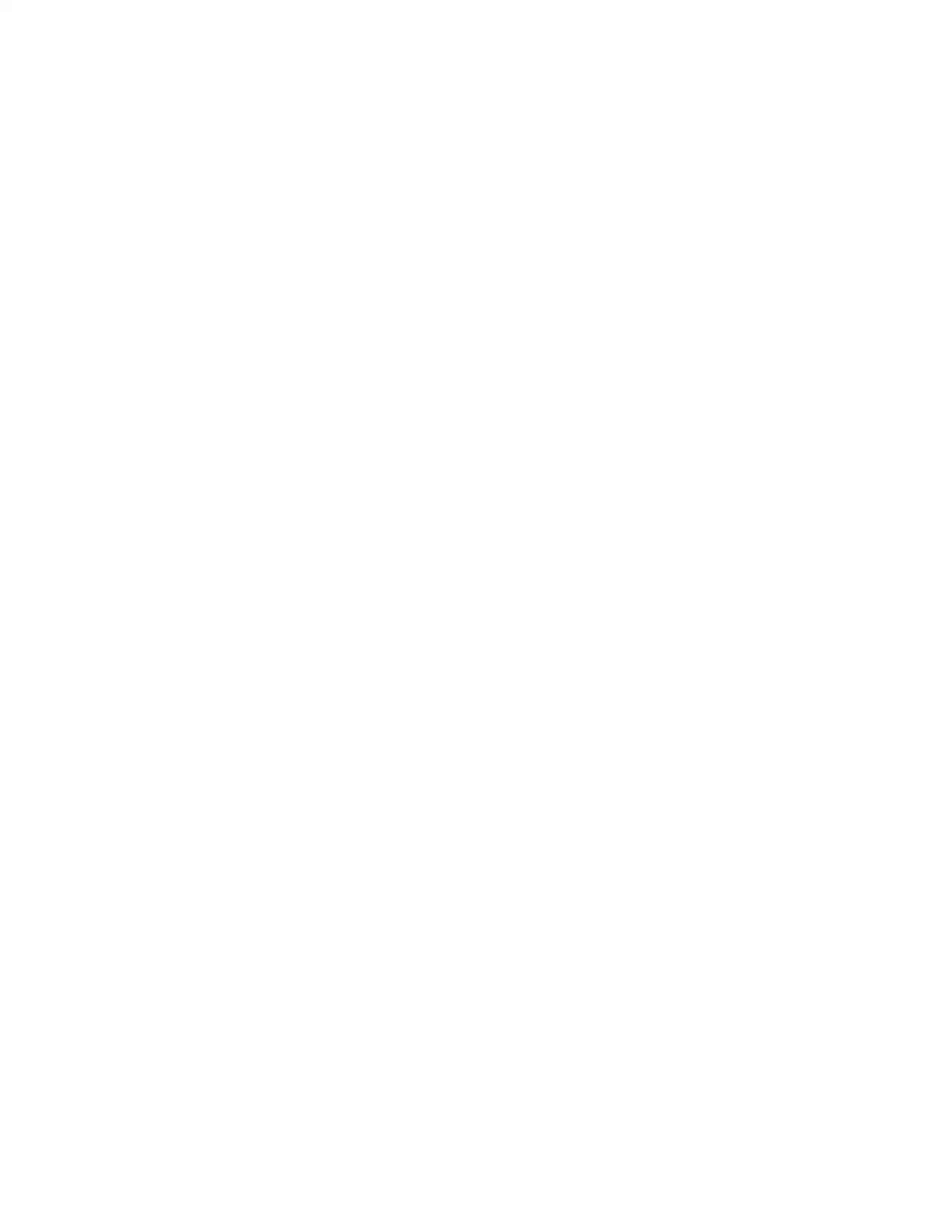

Paraphrase This Document
Need a fresh take? Get an instant paraphrase of this document with our AI Paraphraser

1
1 out of 14
Related Documents
Your All-in-One AI-Powered Toolkit for Academic Success.
+13062052269
info@desklib.com
Available 24*7 on WhatsApp / Email
![[object Object]](/_next/static/media/star-bottom.7253800d.svg)
Unlock your academic potential
© 2024 | Zucol Services PVT LTD | All rights reserved.





